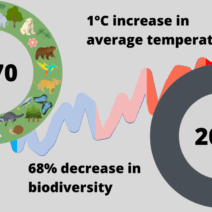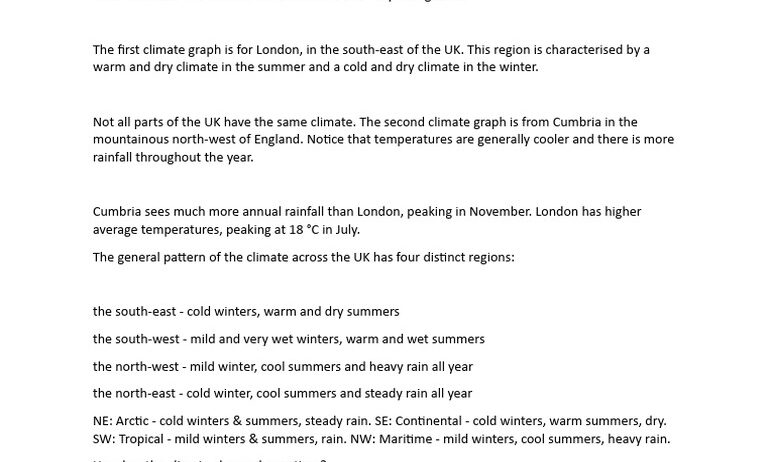When one contemplates the climate of the United Kingdom, a multitude of sensations unfurl like the petals of a splendid flower. The UK’s climate is a cauldron of maritime influences, a narrative inked by the brushstrokes of precipitation and tepid summers. Herein lies a landscape that is both intriguing and perplexing—a symphony in gray hues punctuated by sporadic choruses of sun. This article endeavors to unravel the tapestry of the UK’s climate, particularly focusing on its renowned rainy days and temperate summers, while illustrating the enchanting allure these phenomena hold.
To comprehend the climate of the UK, one must first delve into its geographical tapestry. Positioned as an island nation in the North Atlantic, the UK is cradled by the waters of the Atlantic Ocean, the North Sea, and the Irish Sea. This geographic embrace ensures a temperate maritime climate, marked by mild temperatures year-round, rather than the dramatic extremes witnessed in many continental regions. The climate oscillates like a pendulum, teetering between humdrum and electrifying within the span of a single day.
Rainfall is a signature element of the UK climate, wrapping the land in a mystical shroud. The average annual precipitation can vary greatly across the regions, with areas like the west coast of Scotland and the Lake District receiving the lion’s share, often exceeding 3,000 mm per year. In contrast, the southeast—home to metropolitan hubs—experiences significantly drier conditions. Yet, the omnipresence of rain becomes a background score to everyday life, influencing everything from agriculture to mood.
One cannot discuss the UK without acknowledging the “liquid sunshine,” a euphemism frequently applied to the drizzle that typifies much of the rainy days. The misty streets, glistening with raindrops, transform the mundane into a spectacle. There is an unspoken romance in the way the rain dances upon the cobblestones of London or glides smoothly over the verdant hills of the Cotswolds. Such moments evoke both melancholy and a peculiar joy, nourishing not only the land but also the spirit of the inhabitants.
Despite the seemingly unending gloom, the UK experiences its fair share of sunlight, particularly during the summer months. Gradually, as the Earth tilts closer to the sun, the clouds tend to part, unveiling rays that stimulate the flora. Summer in the UK is not characterized by the blistering heat often expected in other temperate regions. Instead, it offers mild warmth, akin to a gentle embrace. Average temperatures hover around 15 to 25 degrees Celsius, allowing for comfortable activities without the oppressive humidity that can render outdoor endeavors unbearable.
During these ephemeral summer months, the UK metamorphoses into a vibrant tableau. Gardens bloom with resplendent colors, parks become locales for picnics, and coastal areas welcome flocks seeking respite from life’s tribulations. The juxtaposition of rain-soaked fields against azure skies creates a painterly effect, reminiscent of an Impressionist masterpiece. Rural festivals, outdoor concerts, and spontaneous barbecues become ritualistic celebrations of this transient season, uniting people under a canopy of blue, even if just for a fleeting moment.
Amongst the myriad of elements that shape the weather, the Gulf Stream is an often-overlooked actor, imparting a balmy influence that softens the westerly winds that would otherwise chill the land. This ocean current carries warmth from equatorial regions to the northwest shores of Europe, resulting in this temperate climate that is a hallmark of the UK. The balance maintained between the rain and warmth leads to a fertile landscape that has inspired countless poets and artists, all of whom have extolled its verdant beauty.
Yet, with the pervasive rains and moderate temperatures, there come challenges. The frequency of rain can lead to flooding, and intense storms—becoming annoyingly common with climate change—pose risks to agricultural stability and urban infrastructure. Rising sea levels threaten coastal settlements, painting a vivid picture of a relationship that is beginning to fray at the seams. Societal adaptation is crucial; innovation in water management and urban planning is a necessity in maintaining the delicate balance between nature’s whims and humanity’s needs.
Ultimately, the climate of the UK showcases an enigma wrapped in droplets. It encompasses a unique ethos, uniting people under umbrellas and mismatched rain jackets, while simultaneously allowing them to bask beneath the shy sun. Rainy days are not merely inconveniences; they are the lifeblood of a lush and striking environment—an essential narrative thread in the story of Britain. The mild summers, conversely, invoke a jubilant exhalation; a reminder of nature’s capacity for change and continuity, rolling through seasons like a tapestry woven from both sunlight and shadow.
In essence, the climate of the UK is an eloquent reminder of nature’s duality, with rainy days serving as a prelude to vibrant summers. The interplay between precipitation and warmth crafts a milieu that is rich, complex, and deeply inspiring. This is not merely a description of weather; it is an exploration of life itself, where each drop of rain contributes to a greater existence, nurturing both the land and its people in an intricate dance of interdependence.







